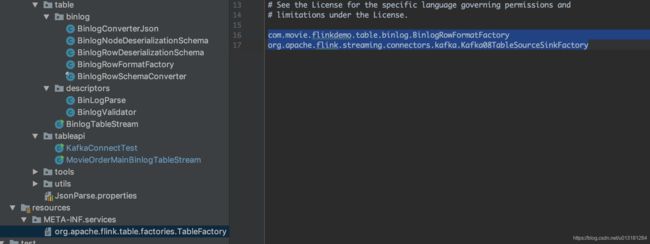flink table api 自定义数据格式解析
flink table api目前支持的数据格式(https://ci.apache.org/projects/flink/flink-docs-release-1.7/dev/table/tableApi.html )除基础数据格式外还支持pojo,但毕竟支持有限,我们希望通过固定的解析,就能直接从kafka直接消费数据,并封装成register table,以供sql查询。本文主要说明如何实现flink对binlog的支持。
1、flink的数据解析入口
以下是flink table api接入消费kafka json格式数据的代码片段,可以看到withFormat函数传入的是一个new Json()对象,我们查看一下下flink-Json的源码
StreamExecutionEnvironment env = StreamExecutionEnvironment.createLocalEnvironment();
StreamTableEnvironment tableEnv = TableEnvironment.getTableEnvironment(env);
tableEnv.connect(
new Kafka()
.version("0.10")
.topic("binlog.movieorderera01_movie_u_order_sharding")
.startFromEarliest()
.property("zookeeper.connect", "localhost:2181")
.property("bootstrap.servers", "localhost:9092"))
.withFormat(new Json().deriveSchema())
.withSchema(
new Schema()
.field("COD_USERNO","string")
.field("COD_USER_ID","string"))
.inAppendMode()
.registerTableSource("sm_user");
tableEnv.sqlQuery("select * from sm_user").printSchema();
源码目录如下,可以看出,flink-json的目录下有两个包,首先看descriptors,下面有两个类,其中Json这个类就是上面代码中调用的,所以我们需要些两个类BinLogParse和BinlogValidator,不需要做很多操作,复制改名并修改里面的成员变量名称就可以。代码如下

BinLogParse.java
public class BinLogParse extends FormatDescriptor {
private Boolean failOnMissingField;
private Boolean deriveSchema;
private String binlogSchema;
private String schema;
/**
* Format descriptor for Binlog.
*/
public BinLogParse() {
super(FORMAT_TYPE_VALUE, 1);
}
/**
* Sets flag whether to fail if a field is missing or not.
*
* @param failOnMissingField If set to true, the operation fails if there is a missing field.
* If set to false, a missing field is set to null.
*/
public BinLogParse failOnMissingField(boolean failOnMissingField) {
this.failOnMissingField = failOnMissingField;
return this;
}
/**
* Sets the JSON schema string with field names and the types according to the JSON schema
* specification [[http://json-schema.org/specification.html]].
*
* The schema might be nested.
*
* @param binlogSchema JSON schema
*/
public BinLogParse binlogSchema(String binlogSchema) {
Preconditions.checkNotNull(binlogSchema);
this.binlogSchema = binlogSchema;
this.schema = null;
this.deriveSchema = null;
return this;
}
/**
* Sets the schema using type information.
*
*
JSON objects are represented as ROW types.
*
*
The schema might be nested.
*
* @param schemaType type information that describes the schema
*/
public BinLogParse schema(TypeInformation schemaType) {
Preconditions.checkNotNull(schemaType);
this.schema = TypeStringUtils.writeTypeInfo(schemaType);
this.binlogSchema = null;
this.deriveSchema = null;
return this;
}
/**
* Derives the format schema from the table's schema described using {@link Schema}.
*
* This allows for defining schema information only once.
*
*
The names, types, and field order of the format are determined by the table's
* schema. Time attributes are ignored if their origin is not a field. A "from" definition
* is interpreted as a field renaming in the format.
*/
public BinLogParse deriveSchema() {
this.deriveSchema = true;
this.schema = null;
this.binlogSchema = null;
return this;
}
/**
* Internal method for format properties conversion.
*/
@Override
public void addFormatProperties(DescriptorProperties properties) {
if (deriveSchema != null) {
properties.putBoolean(FORMAT_DERIVE_SCHEMA(), deriveSchema);
}
if (binlogSchema != null) {
properties.putString(FORMAT_BINLOG_SCHEMA, binlogSchema);
}
if (schema != null) {
properties.putString(FORMAT_SCHEMA, schema);
}
if (failOnMissingField != null) {
properties.putBoolean(FORMAT_FAIL_ON_MISSING_FIELD, failOnMissingField);
}
}
}
BinlogValidator.java
public class BinlogValidator extends FormatDescriptorValidator {
public static final String FORMAT_TYPE_VALUE = "binlog";
public static final String FORMAT_SCHEMA = "format.schema";
public static final String FORMAT_BINLOG_SCHEMA = "format.biinlog-schema";
public static final String FORMAT_FAIL_ON_MISSING_FIELD = "format.fail-on-missing-field";
@Override
public void validate(DescriptorProperties properties) {
super.validate(properties);
properties.validateBoolean(FORMAT_DERIVE_SCHEMA(), true);
final boolean deriveSchema = properties.getOptionalBoolean(FORMAT_DERIVE_SCHEMA()).orElse(false);
final boolean hasSchema = properties.containsKey(FORMAT_SCHEMA);
final boolean hasSchemaString = properties.containsKey(FORMAT_BINLOG_SCHEMA);
if (deriveSchema && (hasSchema || hasSchemaString)) {
throw new ValidationException(
"Format cannot define a schema and derive from the table's schema at the same time.");
} else if (!deriveSchema && hasSchema && hasSchemaString) {
throw new ValidationException("A definition of both a schema and JSON schema is not allowed.");
} else if (!deriveSchema && !hasSchema && !hasSchemaString) {
throw new ValidationException("A definition of a schema or JSON schema is required.");
} else if (hasSchema) {
properties.validateType(FORMAT_SCHEMA, true, false);
} else if (hasSchemaString) {
properties.validateString(FORMAT_BINLOG_SCHEMA, false, 1);
}
properties.validateBoolean(FORMAT_FAIL_ON_MISSING_FIELD, true);
}
}
2、flink数据解析(解析部分)
入口部分有了,那我们来看看解析部分,先看formats.json这个包下的类,我们可以看到JsonRowDeserializationSchema这个文件,这是flink反序列化kafka json数据的类,同样,我们复制并改写这个类,改写deserialize 方法,代码如下:
BinlogRowDeserializationSchema.java
....
....
@Override
public Row deserialize(byte[] message) throws IOException {
try {
CanalEntry.Entry entry = BinlogEntryUtil.deserializeFromProtoBuf(message);
BinlogEntry binlogEntry = BinlogEntryUtil.serializeToBean(entry);
String tablename = binlogEntry.getTableName();
//for (BinlogRow binlogRow : binlogEntry.getRowDatas()) {
List dataRows = binlogEntry.getRowDatas();
//if (dataRows.size()>0){
BinlogRecordBean binlogRecordBean = new BinlogRecordBean(binlogEntry.getExecuteTime(), tablename, binlogEntry.getEventType(), dataRows.get(0));
JsonNode root=objectMapper.readTree(binlogRecordBean.toString());
}
return convertRow(root, (RowTypeInfo) typeInfo);
}catch (Throwable t) {
throw new IOException("Failed to deserialize JSON object.", t);
}
}
这里是将binlog解析为json,这样就能减少重写代码。
然后在重写BinlogRowFormatFactory的createDeserializationSchema,和
@Override
public DeserializationSchema createDeserializationSchema(Map properties) {
final DescriptorProperties descriptorProperties = validateAndGetProperties(properties);
// create and configure
final BinlogRowDeserializationSchema schema = new BinlogRowDeserializationSchema(createTypeInformation(descriptorProperties));
descriptorProperties.getOptionalBoolean(BinlogValidator.FORMAT_FAIL_ON_MISSING_FIELD)
.ifPresent(schema::setFailOnMissingField);
return schema;
}
3、flink 如何运行自定义数据格式
数据解析完了,该如何让flink识别并调用呢,通过查看源码发现,flink调用接口的方式是用的jdk自带的SPI(这里不做多的介绍)方式,只需要在resources/META-INF目录下建立service目录,并在目录下建立和flink table api的 Factory类路径相同的文件(org.apache.flink.table.factories.TableFactory),并在文件里添加上flink-kafka的table source和BinlogRowFormatFactory
com.movie.flinkdemo.table.binlog.BinlogRowFormatFactory
org.apache.flink.streaming.connectors.kafka.Kafka08TableSourceSinkFactory
然后在接入数据时就可以在withFormat调用自定义的数据解析器了,如下
tableEnv.connect(
kafka)
.withFormat(new BinLogParse().deriveSchema())
.withSchema(tableSchema)
.inAppendMode()
.registerTableSource("sm_user");
